32 long years after moving on to bigger and better things within the game, Claudio Ranieri is back in Sardinia at the helm of the 1969/70 Serie A winners Cagliari.
Fans from an older generation will have fond memories of ‘The Tinkerman’ with Gli Isolani, rising from Serie C to Italy’s top-flight division in back-to-back campaigns during his three-year spell from 1988-1991.
It was with Cagliari that the country with a proud footballing heritage stood up and took notice of an exciting young coach in his late 30s, quickly becoming one of the most promising tacticians in the sport.
32 years on, Claudio Ranieri returns with the knowledge of an elder who toured the world, won the hearts of millions and became a legend of the game.
But even as an older man, Claudio Ranieri looks hungrier than ever, ageing like a fine wine in his exquisitely tailored suits and lengthy charcoaled overcoats.
Having been relegated from Serie A last season and winning three games in 15 in all competitions before January rolled around, President Tommaso Giulini called upon Claudio Ranieri to steer Cagliari away from the pitfalls of the relegation battle in Serie B.
Claudio Ranieri duly accepted the challenge, maintaining his status as the only Roman who had been welcomed into Sardinia with open arms.
With the shadow of 2016’s conquering of English football following closely behind the 71-year-old, there is an expectation of greatness and overachievement cast upon any side led by Claudio Ranieri.
The Premier League winner has become a coach for the short term, a man who can deliver instant success rather than a coach who can plan for the future.
At his ripe age, this is truer than ever before.
Will Cagliari thrive under Claudio Ranieri’s tutelage?
Only time will tell.
This tactical analysis will examine Claudio Ranieri’s tactics deployed so far in his return to Sardinia.
Claudio Ranieri Formations
During his first stint with Cagliari over thirty years ago, Claudio Ranieri earned a reputation for being quite tactically flexible.
He could bend to the will of the opponent so that his team didn’t break.
This was observed rather cynically when Claudio Ranieri originally took his first job in England with Chelsea.
In his later years, ‘The Tinkerman’ has become somewhat of a term of endearment but it was initially used as a jibe for the Italian’s constant tinkering with starting lineups and tactics in-game.
Fortunately, Claudio Ranieri fits right in at home with Cagliari, who have used almost every formation imaginable this season under the experienced coach and his predecessor, Fabio Liverani.
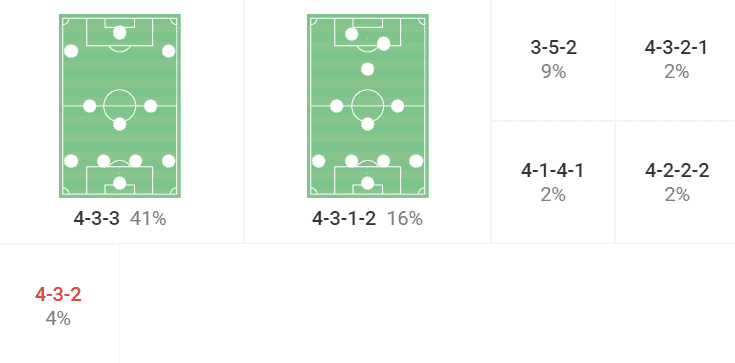
Despite garnering a reputation for utilising a rather basic yet reliable 4-4-2, throughout his first couple of games at the helm, Claudio Ranieri has preferred to deploy back three systems, particularly the 3-4-3 formation or the 3-4-1-2 formation.
But tinkering has never left his blood.
It’s part and parcel of hiring the Italian master tactician.
When he sees something he doesn’t like, he won’t hesitate to change, whether it be a switch in formation, personnel or structure.
In one of Claudio Ranieri’s first matches in charge at the Sardegna Arena, he tweaked the formation three times throughout the game’s lifespan, moving from an initial 3-4-3 formation to a 3-4-1-2 formation and ending with a flat 3-5-2 formation.
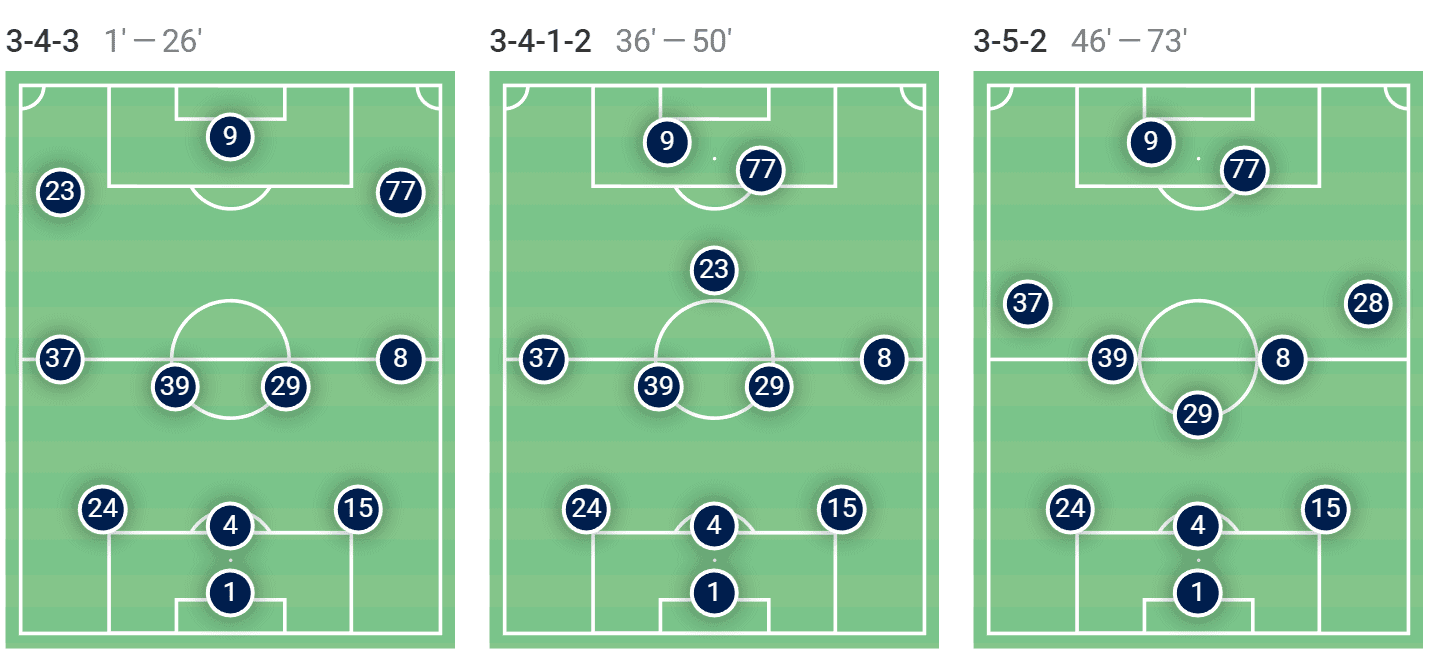
Tinkerman by nickname, tinkerman by nature.
It’s all part of the legendary coach’s awe-inspiring charm.
But as has become increasingly evident in modern football, formations are little more than a reference point for players to know roughly where to be, particularly out of possession.
Apart from being a base of reference, formations are not the most important aspect of football tactics anymore.
What matters most is the system of play.
Let’s take a look at Claudio Ranieri’s style of play and tactics at Cagliari.
Claudio Ranieri’s Attacking Style Of Play
Guardiolan football has become a paradigm in the sport almost 14 years after its birth in Barcelona.
Every young coach aspires to play like Manchester City, every board wants a coach who can instil the same principles of a Pep team, sometimes to the detriment and dismissal of reality.
Pep Guardiola’s spell in Catalonia spilt global reconsiderations about how the game should be played.
A methodology revolved around retaining possession, building out from deep and using different zones to position players during various situations on the pitch.
And with this new paradigm of thinking came a change in defensive structures, how teams pressed, and how they sat back to defend zonally.
Man-marking practically faced extinction apart from a few stragglers.
European football had improved more from a tactical and technical perspective than any other period in history.
But there was a price.
Diversity suffered.
International teams and clubs all followed the same pathway, an identical school of thought, leading to a repetition of style among teams and a fixed mindset of how the game should be played.
Positional play and possession-based approaches have dominated the sport for the guts of five or six years now.
Nonetheless, Claudio Ranieri doesn’t care.
The 71-year-old has a fixed mindset but one centred on results, not process.
For Ranieri, winning is the be-all and end-all of football, a throwback to a simpler time in Serie A.
Who cares how much of the ball you have?
Prior to the Ranieri appointment, Cagliari were averaging 54.4% ball possession per game.
During Ranieri’s brief term so far, this has been reduced to 48.19%.
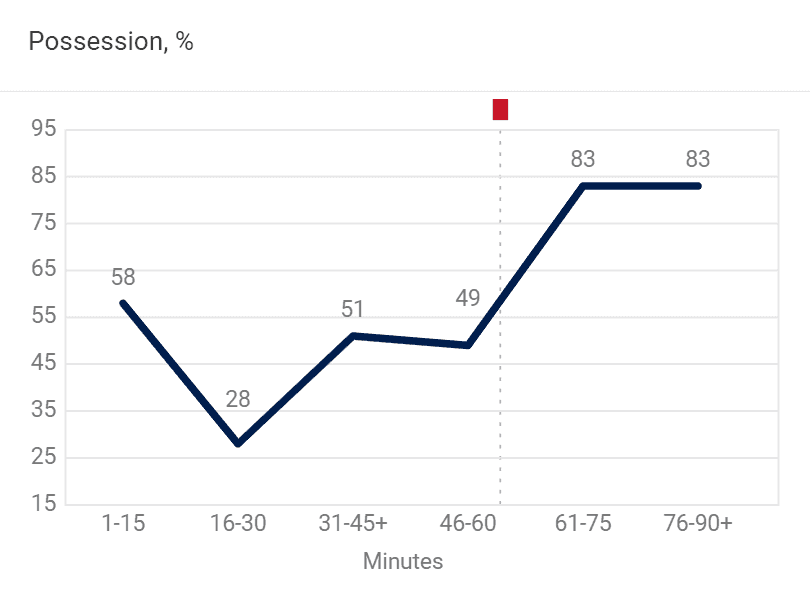
In this goalless draw away from home at Cittadella, Cagliari ended the game with a total of 61.3% of the ball.
However, this number fluctuated throughout the game, reaching as high as 83% but as low as 28%.
Claudio Ranieri’s style of play centres around pragmatism—getting the most out of the players he has at his disposal rather than imposing a far-reaching style to which the players may not be able to adapt.
Cagliari is a hard-working team with players who work tirelessly off the ball, including the technically proficient Uruguay international Nahitan Nández, Ranieri’s most skilled midfielder on the ball.
Nevertheless, the centre-backs are not overly comfortable when playing out from deeper areas.
As such, Ranieri instructs his players to play long to the forward line.
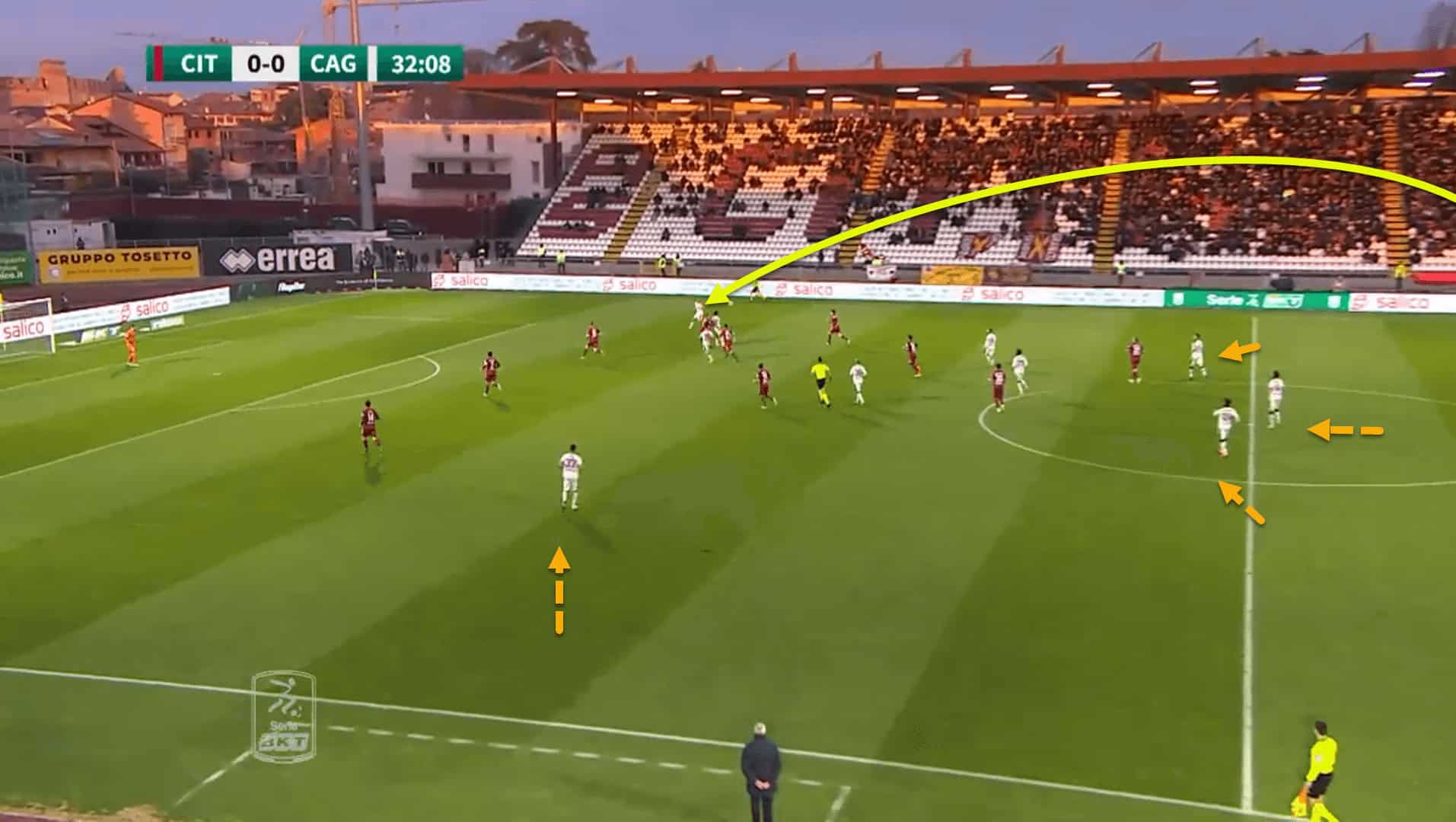
Once the goalkeeper or centre-backs pump it into the opposition’s half of the pitch, the entire team squeezes together to win the second ball and sustain an attack further forward.
One teammate challenges for the ball while others support from deep to be in close proximity in case it’s knocked down and becomes loose.
Meanwhile, Claudio Ranieri also wants at least one player to attack the depth behind the opposition’s backline.
The goalkeeper is incredibly important for Cagliari to bypass the build-up phase.
Boris Radunović has been Ranieri’s man in this respect.
The former Atalanta goalkeeper has been tasked with directing a high volume of passes into the opponent’s half of the pitch so that the team can push up and squeeze together.
Boris Radunović Progressive Passes Map
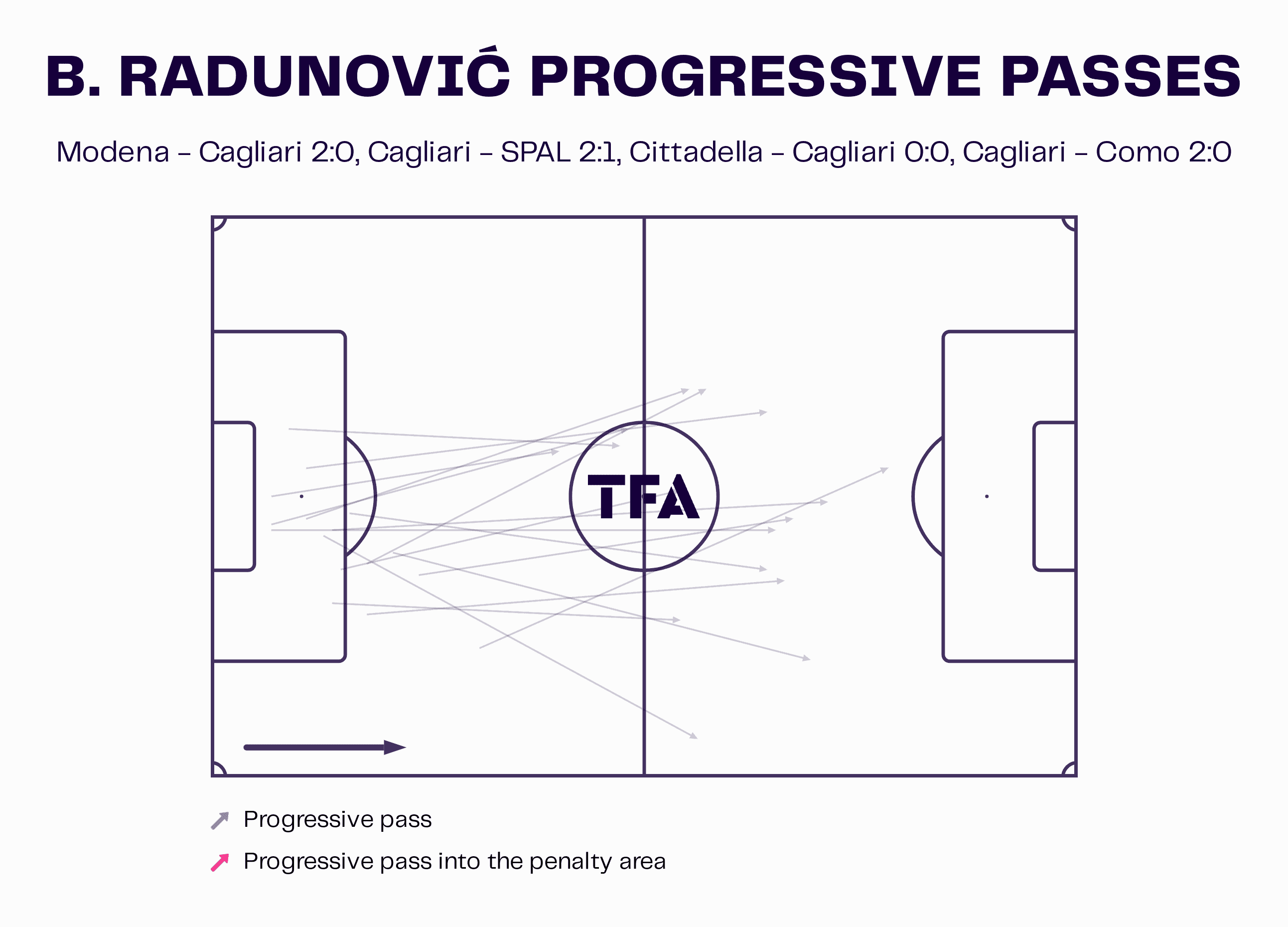
This is evident when closely observing Radunović’s progressive pass map, as we can see how many times the Serbian keeper has been used to progress Cagliari into higher areas of the pitch.
Claudio Ranieri has always advocated for having a player sit just off the centre-forward, whether this is another striker or a supporting player.
Typically, with Cagliari, this has been another number ‘9’, but there have also been times when the experienced manager has opted to use a front three, pushing the wingers inside closer to the primary frontman.
One common component that most of Claudio Ranieri’s side also have is an ability to combine well in the final third, understand each other’s positioning well, and run off of one another.
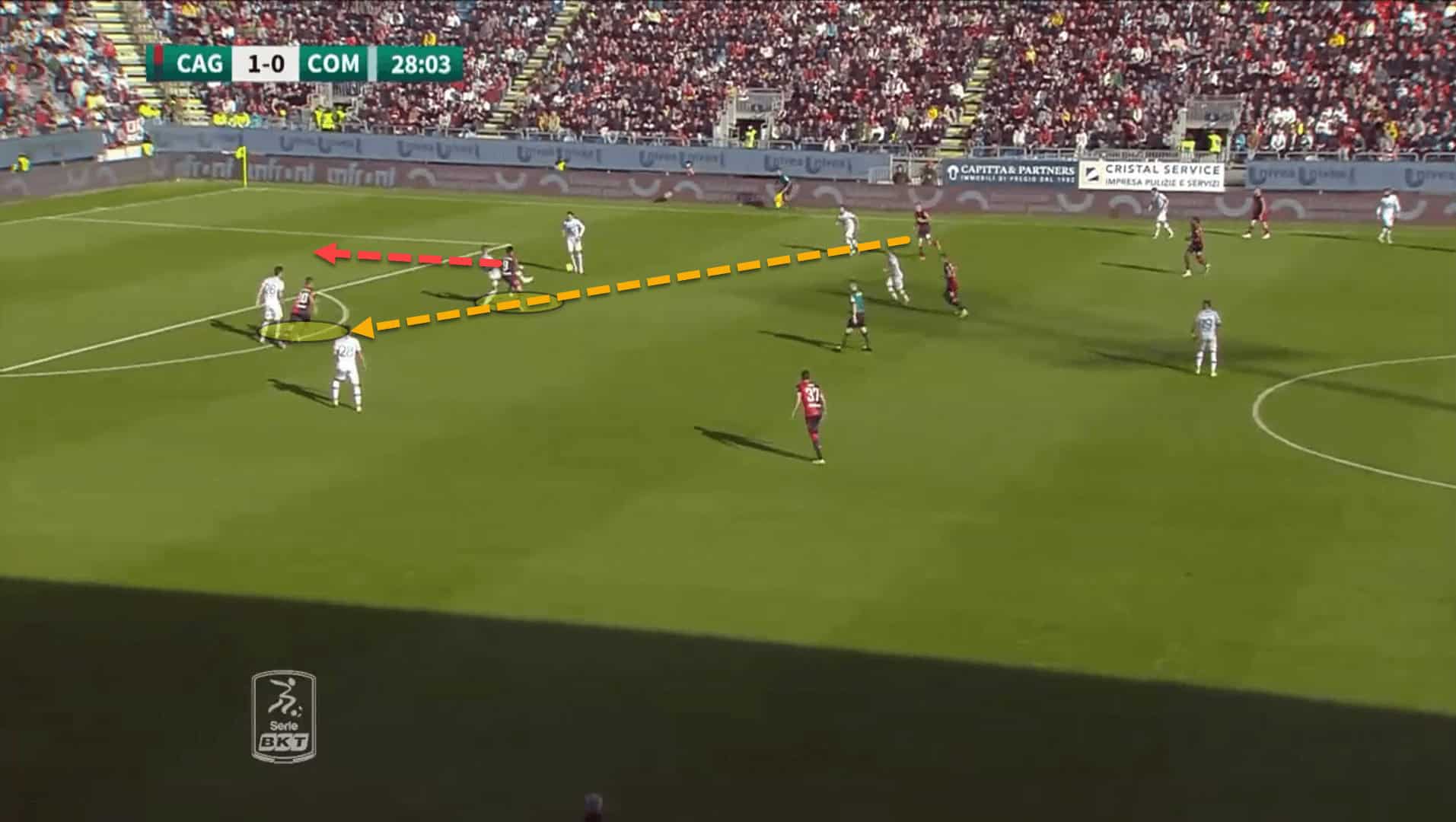
The ball has been lofted directly into the striker partnership up top.
Scanning the space behind him, Gianluca Lapadula starts moving towards the ball before dummying the defender and running behind the backline.
Due to this movement from Lapadula, Leonardo Pavoletti can latch onto the original pass and slip his partner in on goal.
These types of striker runs are a common method used by Cagliari to get into goalscoring positions under the new boss.
These movements are just as important from long balls forward from goal-kicks, too.
Typically, one drops off to challenge while the other begins to run behind.
Already, the frontmen have managed to earn this chemistry together.
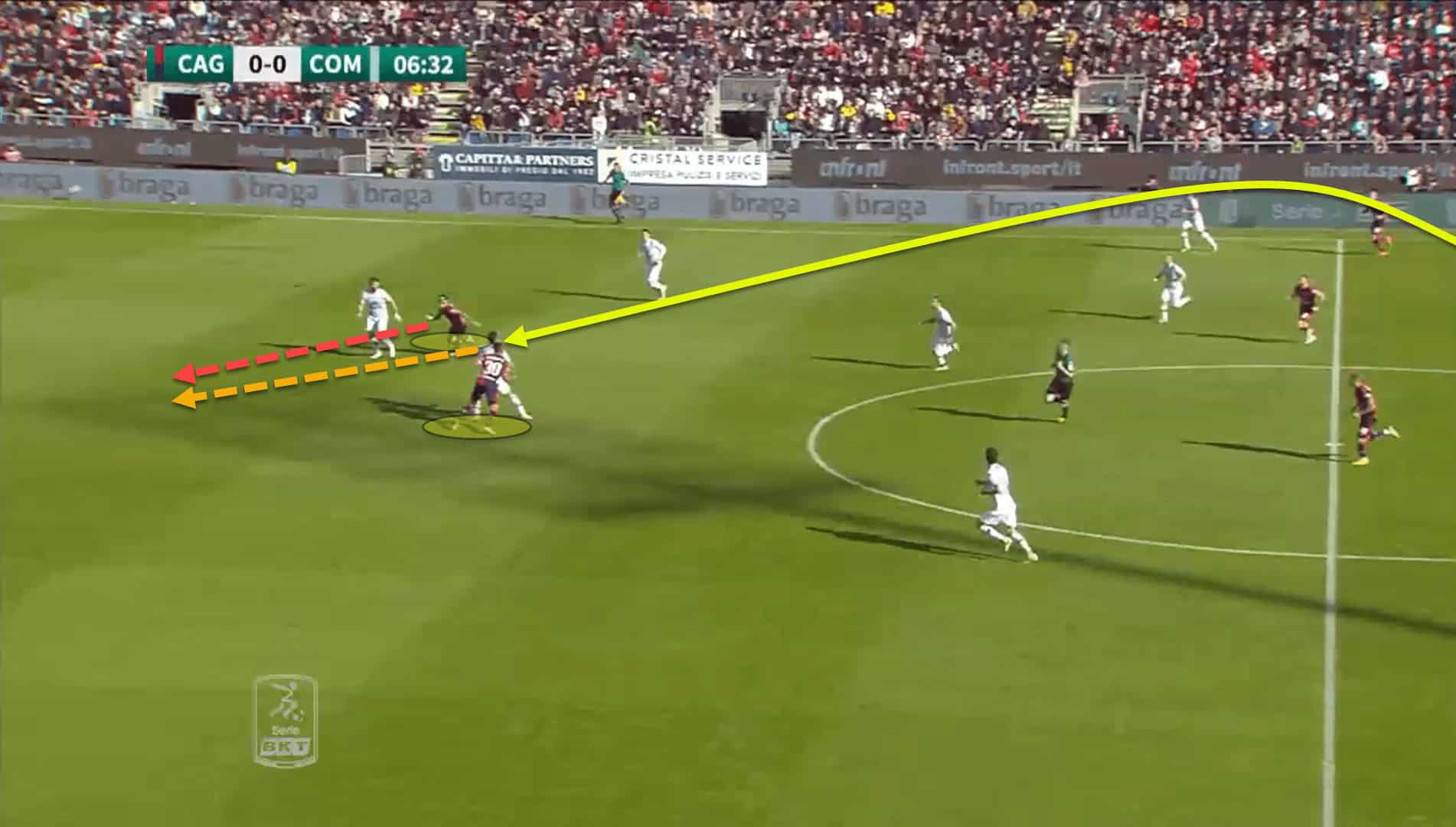
This example is quite similar to the image prior.
One centre-forward is challenging for the aerial ball, which has dragged out the opposition’s centre-back.
Spotting space opening up, his partner makes a run in behind, hoping for the ball to be flicked on to set him away.
Since Ranieri has been at the helm, which, granted, hasn’t been very long, Cagliari has performed quite well in front of goal, registering precisely one goal per game—four in total—while slightly outscoring their xG of 3.95.
Cagliari xG Map
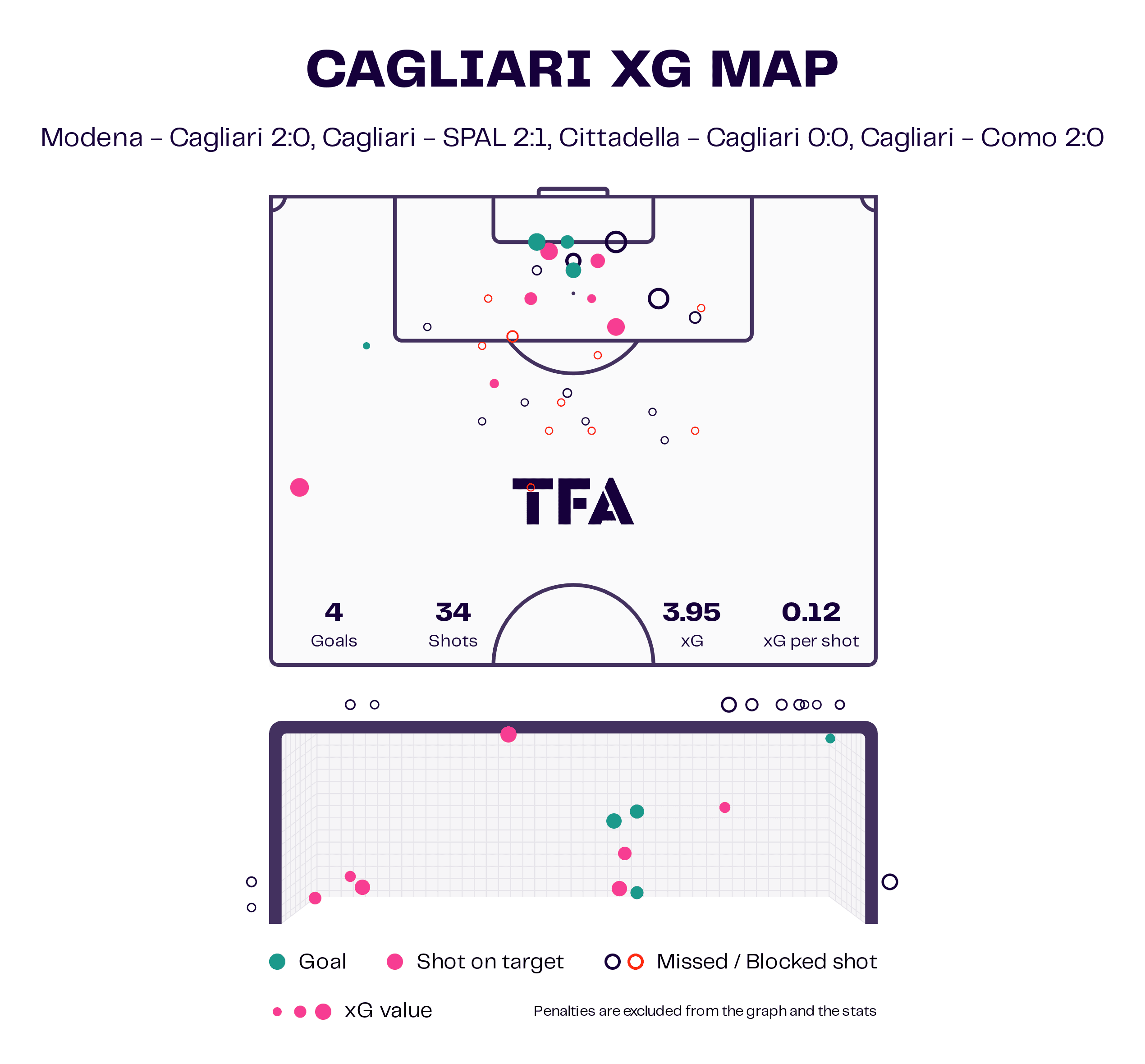
Ranieri’s most significant issue right now is that the Sardinian team is not putting itself into optimal goalscoring positions.
Their xG per shot stands at 0.12, which is relatively low.
Cagliari needs to begin creating better chances and getting into more sustainable goalscoring positions to keep scoring consistently and increase the xG per shot rate, which will have a positive rippling effect.
Claudio Ranieri’s Defense Tactics
By age 71, Ranieri has been all over Europe — contesting football matches from the dugout against some of the greatest minds across Italy, England, Spain, Germany, France and the like.
Yet, Claudio Ranieri’s defensive tactics and principles have never changed.
Shapes come and go, but the idea behind how the manager wants his team to defend has remained consistent throughout his career.
Cagliari is no different from any other side coached by Ranieri—hard-working in the defensive phases and willing to press high up the pitch.
In fact, Gli Isolani are more willing to press the opposition since Ranieri took over than in the half-season prior.
Cagliari is averaging 7.57 Passes allowed per defensive action per game in Ranieri’s matches in charge so far, compared to 9.92 registered under his predecessors.
When it comes to PPDA, the lower the number, the fewer passes a team allows their opponents to have.
When pressing, Cagliari pushes their defensive block right up the pitch to squeeze the space between the lines that the opposition has to play through.
Cagliari Defensive Territory Map
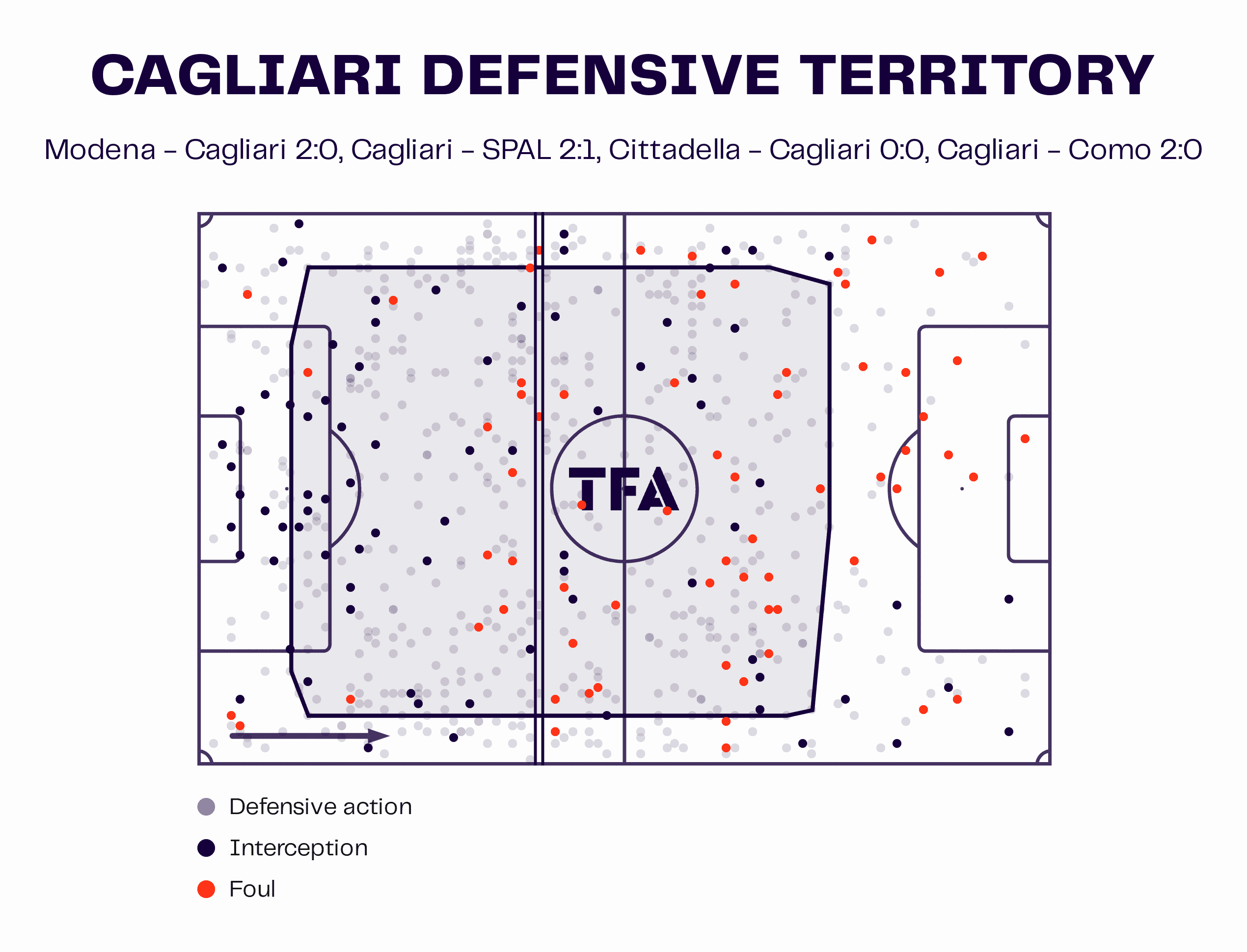
Cagliari’s defensive territory map under Ranieri shows that the average height of the defensive line is close to the halfway line.
There may be a misconception that a Ranieri-led team sits in a deep block for large parts of the game and defends their penalty area.
But this couldn’t be further from the truth.
Even during his last full season in charge, the 2020/21 campaign with Sampdoria, when the Blucerchiati respectably finished in the top half of the table, Ranieri’s team pressed really high up the pitch, boasting a defensive line height similar to that of Cagliari under his tutelage.
Sampdoria Defensive Territory Map
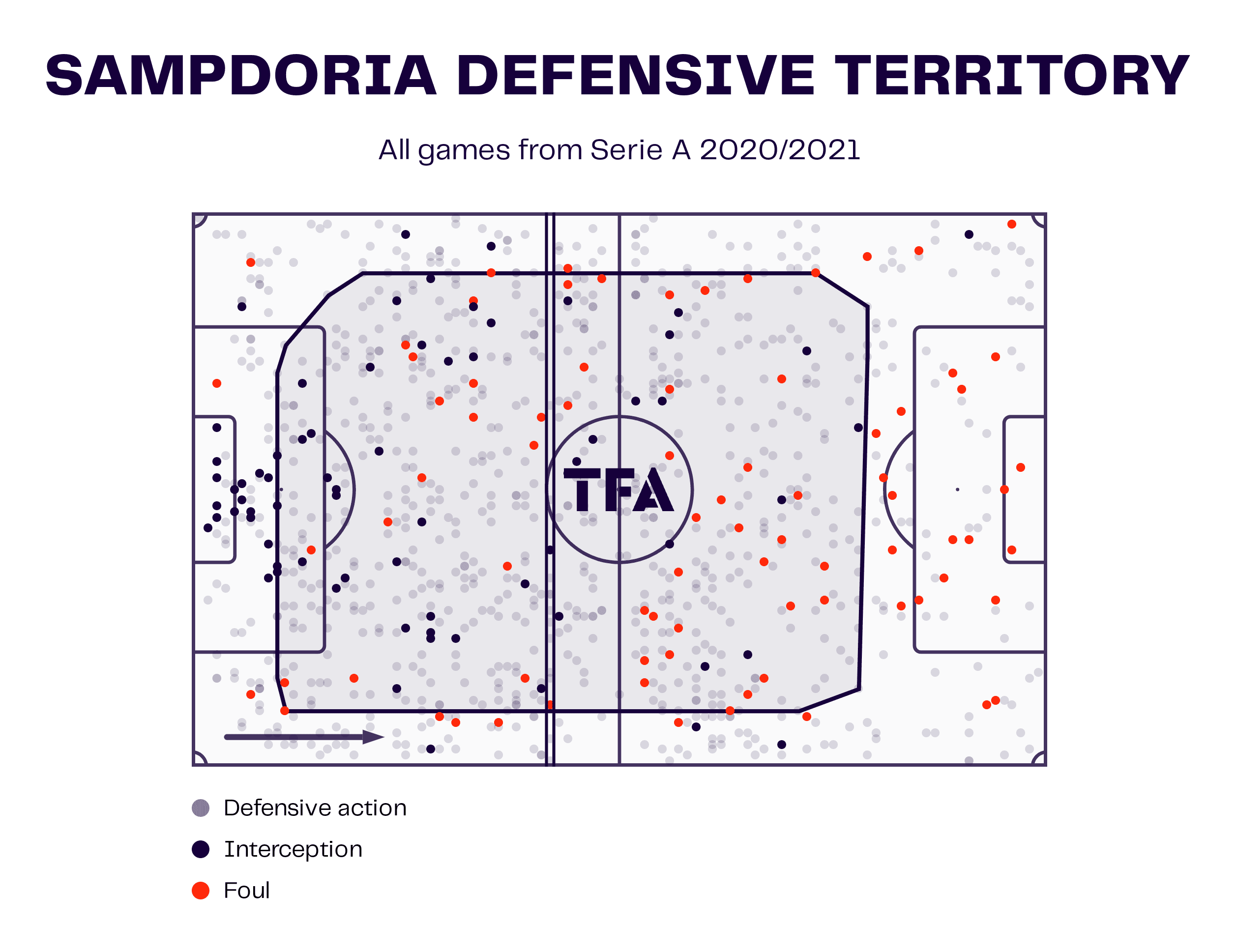
In fact, the only real outlier for The Tinkerman was his tenure in the English East Midlands.
With Robert Huth and Wes Morgan at the back, Leicester City was forced to sit off teams regularly.
Huth and Morgan were as reliable as a Roy Keane frown, but it would have been an injustice to their lack of speed if the Foxes’ boss instructed the centre-backs to defend at the halfway line.
Instead, Leicester dropped off into a more compact defensive block, reducing the space between the backline and the goalkeeper to prevent balls in behind.
Leicester City Defensive Territory Map
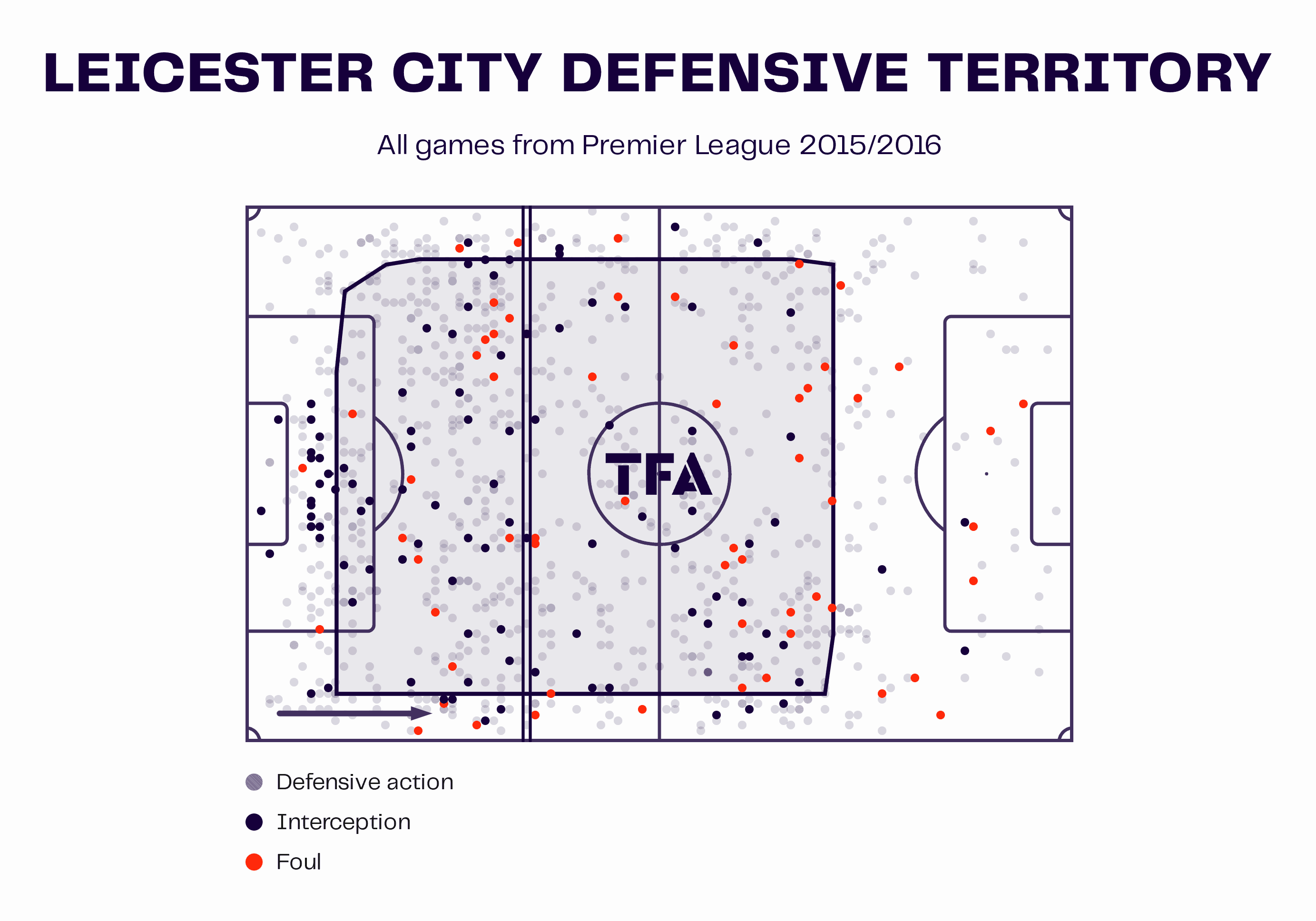
Given Cagliari doesn’t lack speed in that department, having central defenders such as Elio Capradossi and Alberto Dossena in their ranks.
This allows the Sardinians to push their defensive block higher to press in the final third without a crippling feeling that a ball behind would tear them into a million minuscule pieces.
When pressing a team in the final third, Cagliari’s objective is to force the opponent to one side of the pitch, using the forward line’s pressing runs to make this possible.
Cagliari’s pressing style depends on its formation and that of the opposition.
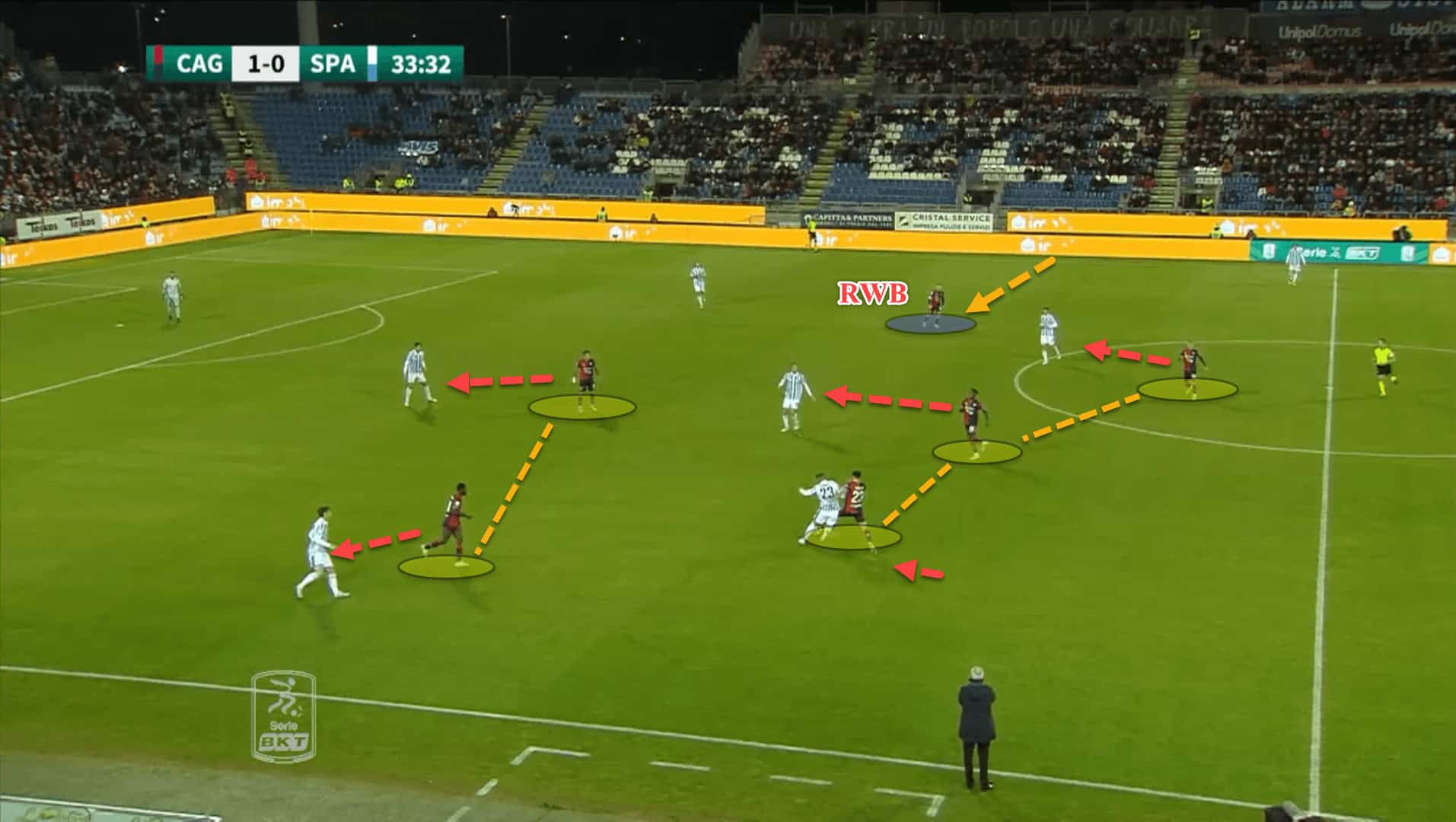
Here, Cagliari were pressing against SPAL’s 3-3 build-up shape.
Ranieri set his side up in a 3-5-2 formation but the structure resembles more of a 4-5-1 formation.
This is because the front two players have pressed SPAL’s backline, keeping the opposition to one side of the pitch.
To provide balance on the far side, the right wingback has tucked inside to squeeze the space and make the pitch smaller for the opponent.
Hence, the shape looks like a 4-5-1 formation but is very much a 3-5-2 formation.
Nonetheless, when the ball is moved to the wide areas, Ranieri’s men lock on.
This means that they adopt a tight man-marking approach on the flanks, using the wide areas as an extra man.
This also involves using the centre-backs aggressively.
Often, the wingbacks will be occupied marking a wide player, so the centre-backs will have to be ready to step up and follow an attacking player into a deeper area if they are unmarked.
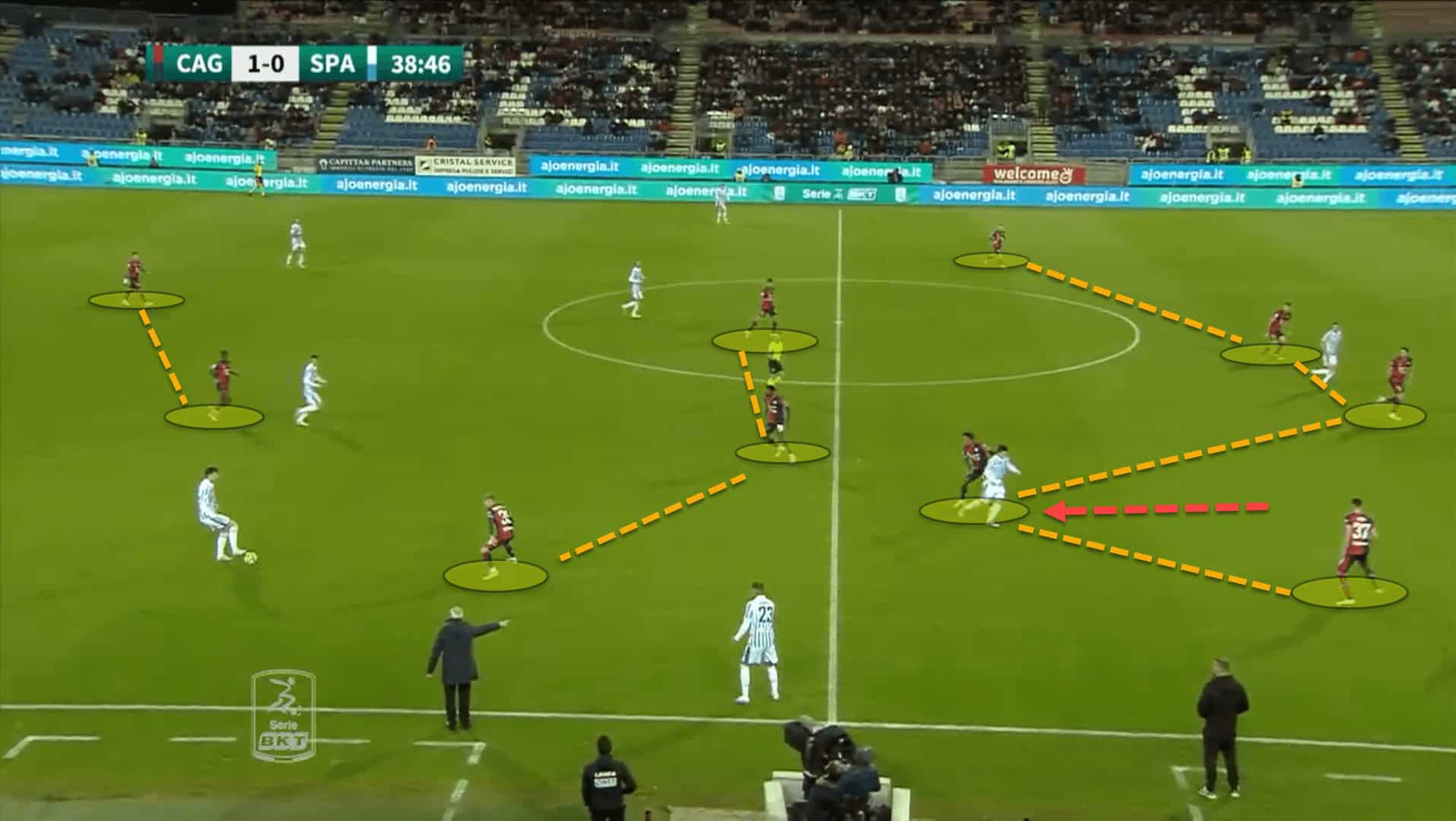
Again, here, Cagliari was defending in a 3-5-2 formation.
As the left wingback was unmarked, Capradossi — the left centre-back — followed the SPAL attacker into a higher area, stepping out of the defensive line to do so.
At the same time, the rest of the defence squeezed together to close the vacated space.
Ranieri wants his team to spend most of the game defending in this mid-to-high block phase, not in and around their penalty area, where the opposition is a threat.
This is why the 71-year-old has been adamant that his players press higher up the pitch and try to force the opponent into giving the ball away.
Cagliari High Regains Map
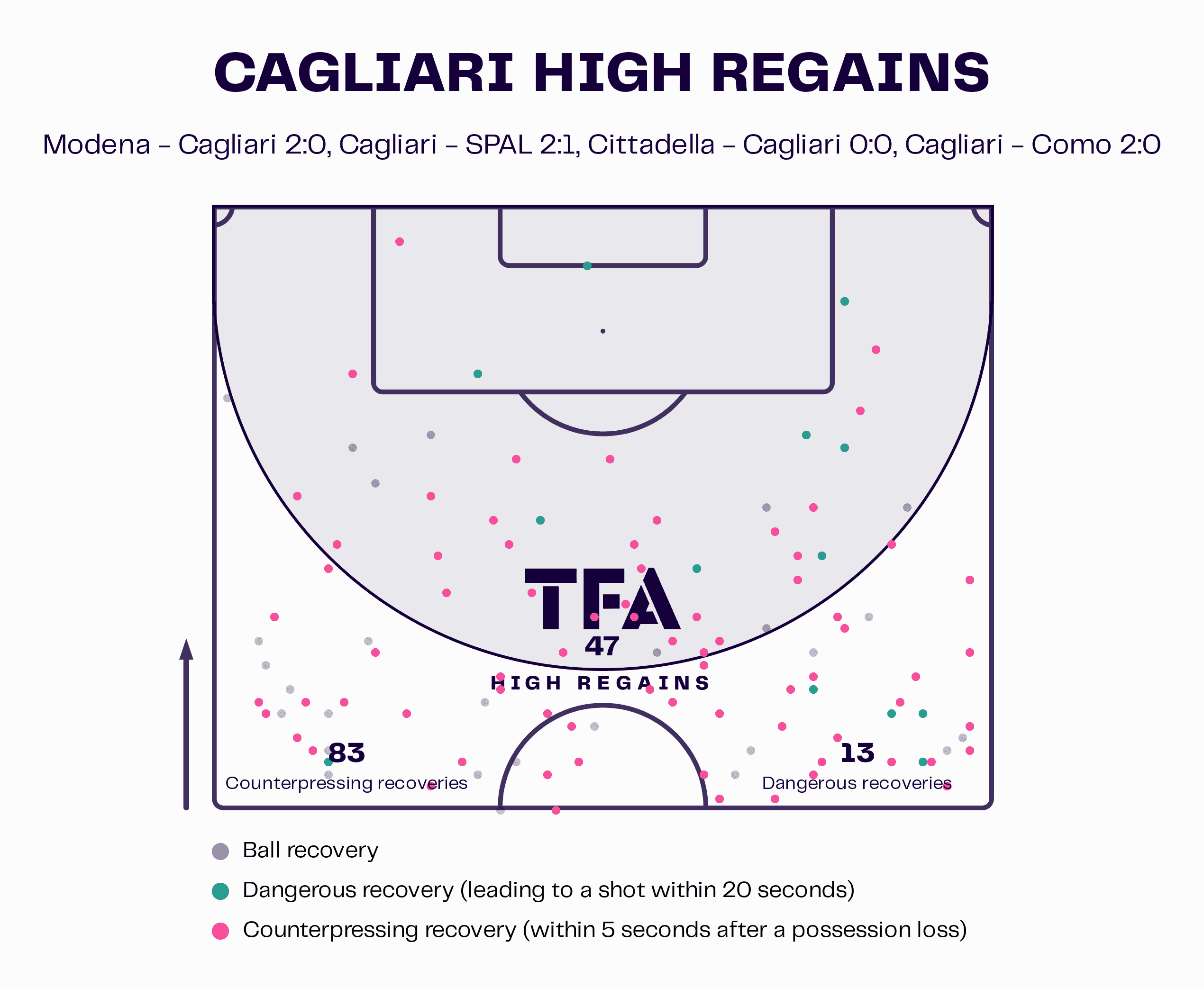
From his first few games in charge, Cagliari’s pressing numbers are quite impressive, registering 37 high regains in the opposition’s half, 65 counter-pressing recoveries and 10 dangerous recoveries already.
Maintaining a mid-block state allows Cagliari to counterattack swiftly and efficiently, which has become a staple of any Claudio Ranieri team over the past few decades.
A medium-level defensive block is not so high up the pitch as to be susceptible to balls in behind but not as deep as a low block, where it is harder to create an effective counterattack from your own penalty area.
It is at just an excellent height, right where Ranieri wants his players to win the ball back and break forward, which is exactly what they’ve done so far.
Claudio Ranieri Counterattacking Style
Ranieri and counterattacks go hand in hand.
Everyone remembers Leicester City’s free-flowing, fluid, fruitful football during the 2015/16 campaign.
Jamie Vardy hitting the channels with scintillating speed, Riyad Mahrez making fullbacks look like lampposts, Marc Albrighton hitting David Beckham-esque crosses from deep, and N’Golo Kante doing… well, everything.
Leicester were a joy to watch once space opened up behind an opponent’s backline in transition.
Like true Foxes, the players waited for the right moment to strike before picking off their prey.
Ranieri had turned his skulk from weaning cubs into vicious predators.
Of course, the Italian tactician had much more time to implement his philosophy on the side, and the players had gelled together for much longer.
However, it is still clear that Cagliari is slowly but surely shaping up in a similar manner.
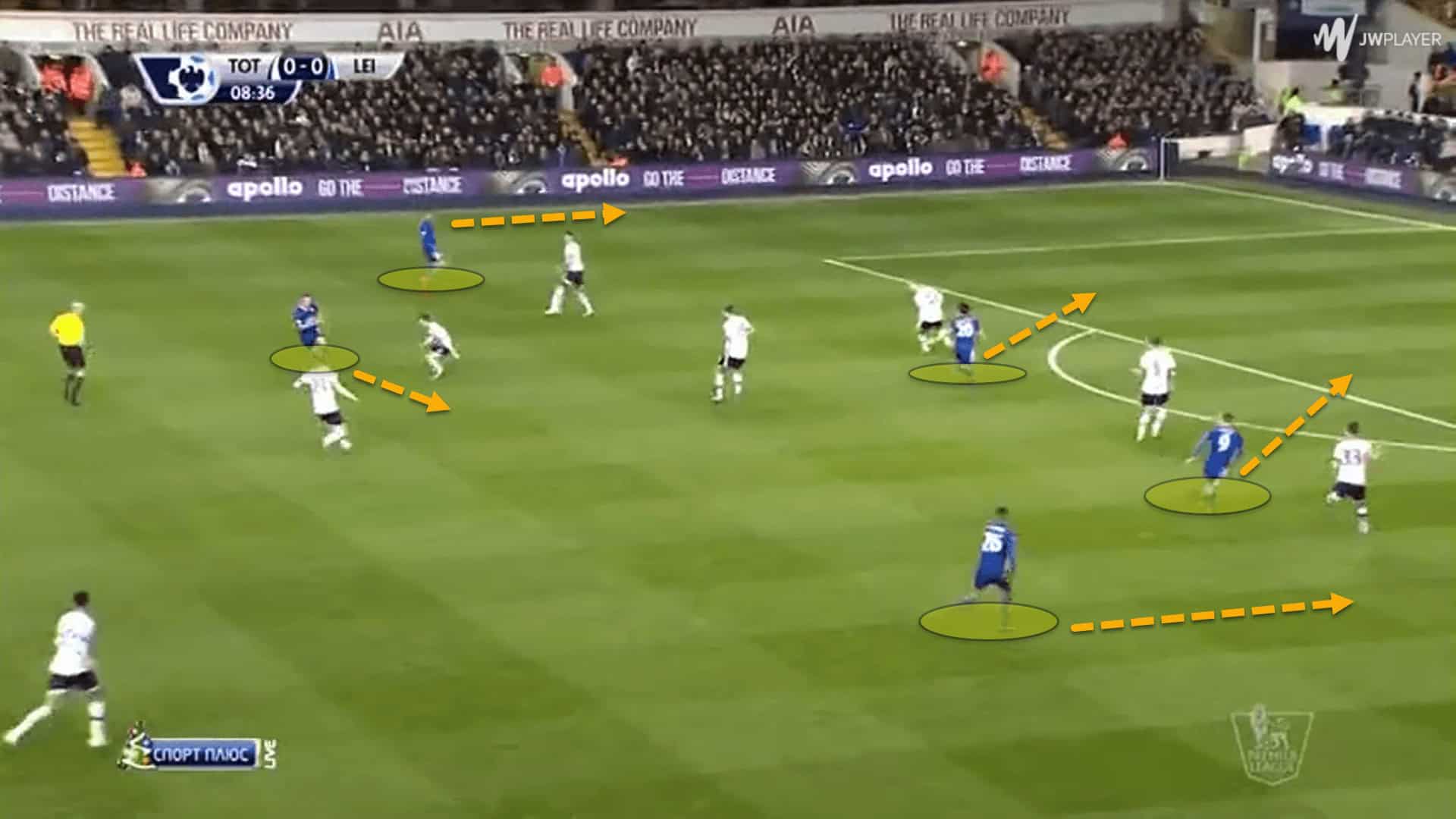
In the East Midlands, Ranieri famously deployed a 4-4-2 to great success.
Within this conventional shape, the tactician liked to adopt a five-up, five-down approach.
This basically means that when counterattacking, five players go forward to attack the opposition’s goal, while five sit back to offer balance in case of a turnover of possession.
Transitions can be deadly against an opponent but can also be lethal for the counterattacking side if the right balance is not in place for moments when the attack is stifled.
As shown in the previous image, Leicester attacked with both wingers, both centre-forwards, and one fullback, holding the double pivot, two centre-backs, and the right-back deeper on the pitch in case the counterattack was halted.
Claudio Ranieri is adopting a similar counterattacking style at Cagliari.
Of course, the positions differ, given that Ranieri mainly uses a 3-5-2 instead of Leicester’s 4-4-2.
However, the principles remain the same.
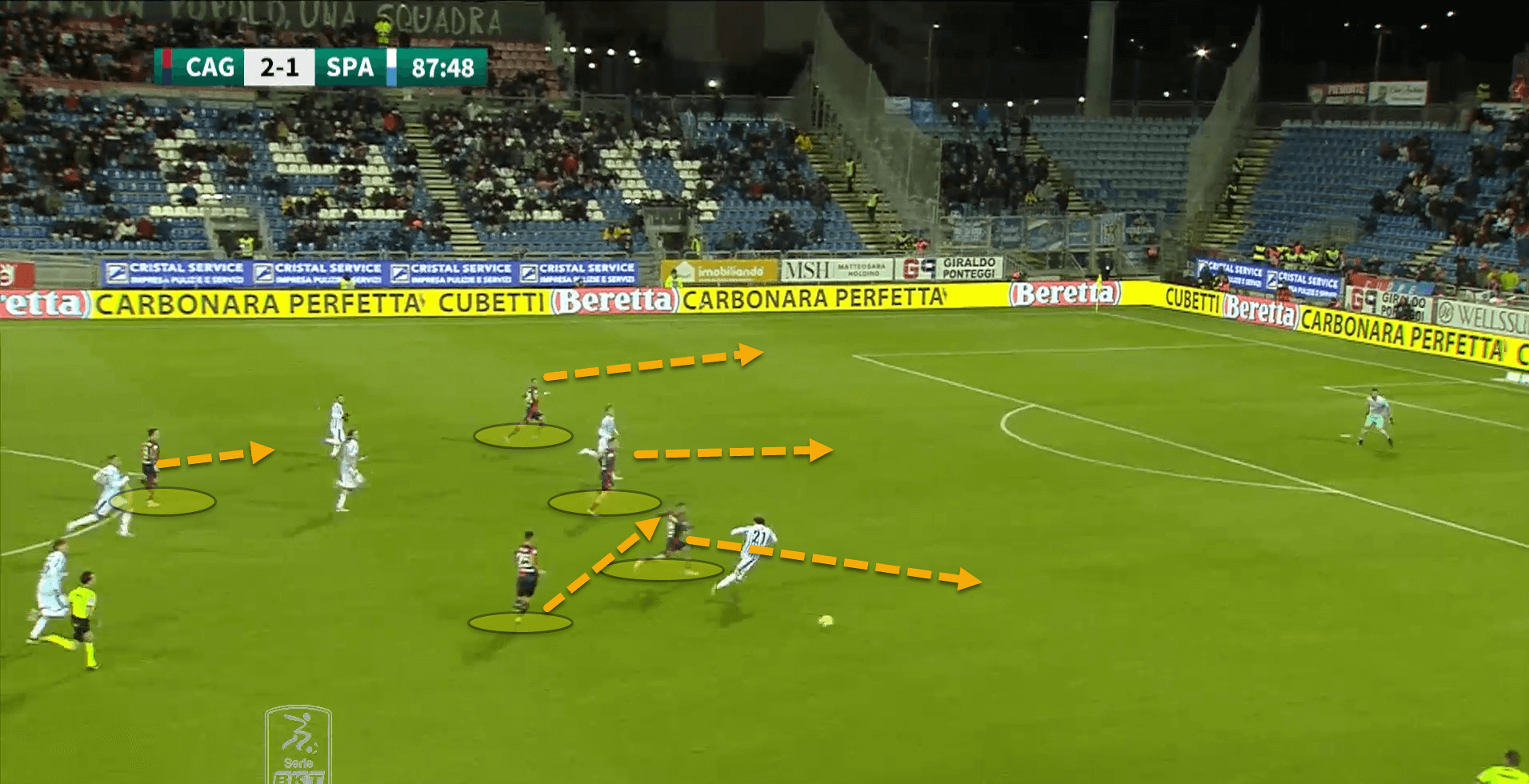
Five players bomb forward, attacking space in the opposition’s backline to try and create overloads against the centre-backs to double-up on them or to get the defenders, possibly even in 1v1 situations.
Interestingly, under Ranieri, Cagliari has yet to score from a counterattack and has not shown the same potency as the great Leicester side of almost seven years ago.
Still, the Tinkerman has only been in charge for a couple of weeks.
This aspect of Cagliari’s game is bound to improve under the boss with more analysis and time on the training ground.
Conclusion
Ranieri will not go down as one of the great entertainers in football history, unlike coaches such as Marcelo Bielsa, Pep Guardiola and Arsène Wenger.
He’s a practical man who seeks to get the most out of his players by appealing to their hearts, not their minds—a throwback to a revered time in the sport when reality trumped purism.
Ranieri may never have been able to replicate the miracle of 2016, and most of his appointments in the past seven years since have fizzled out quicker than sodium in water.
However, when Ranieri finally hangs up his dusty black coat, the game will be worse without him.
A legend in its pedantic form, it’s a true joy to watch the T(h)inkerman still compose his symphonies on the sideline in Sardinia all these years later.






Comments